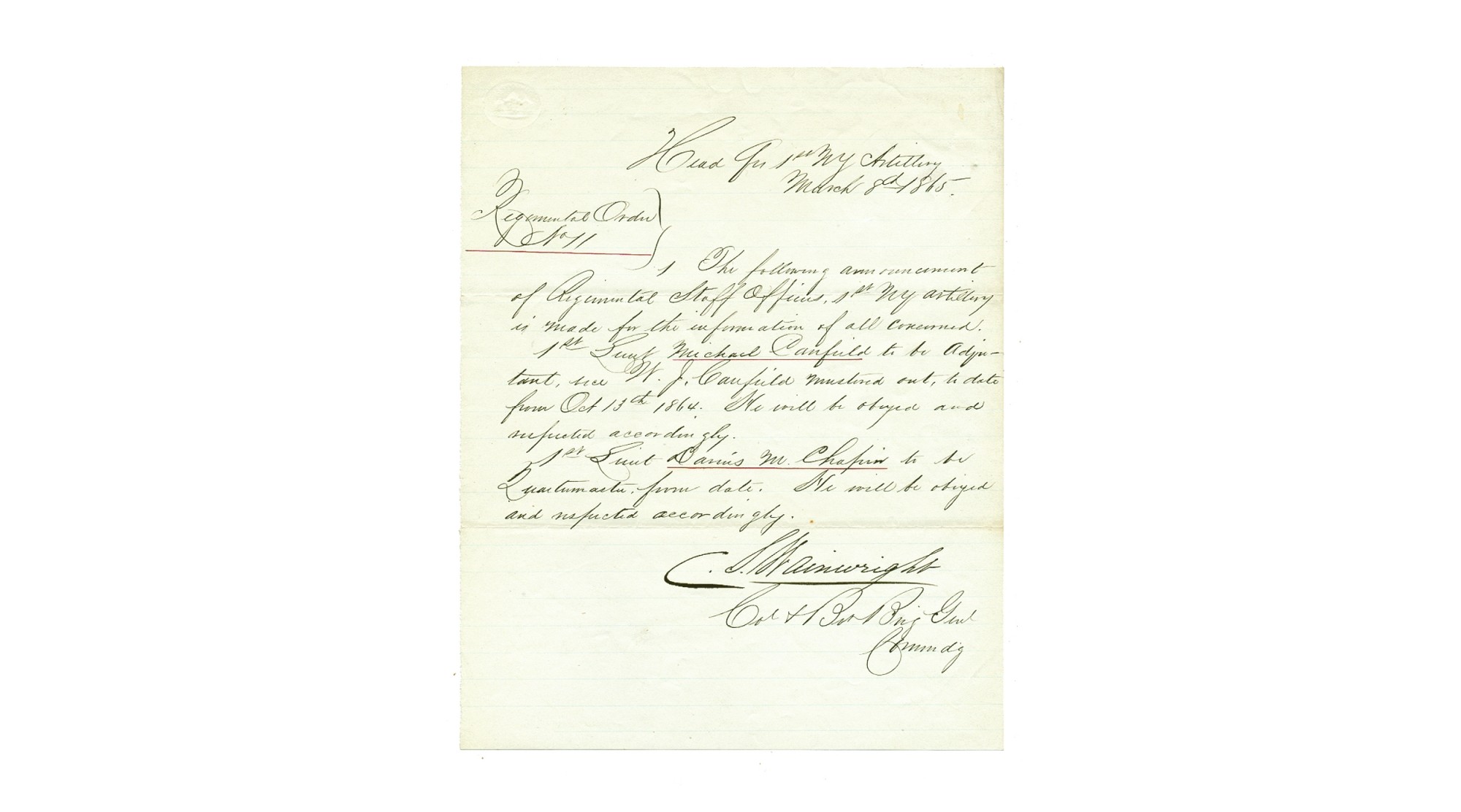site search
online catalog
1865 DS – REGIMENTAL ORDER SIGNED BY COL. & BVT. GEN. CHARLES WAINWRIGHT

$250.00 SOLD
Quantity Available: None
Item Code: L14613
This war dated Document Signed Regimental Order is in very fine condition, signed boldly by Wainwright, a rare and desirable Gettysburg General’s signature. In ink on a lined piece of paper measuring 7 ¾” x 9 7/8”; very clean, all writing legible. Text reads:
Head Qrs 1st NY Artillery
March 8th 1865
Regimental Order
No. 11
The following announcement
of Regimental Staff Officers, 1st NY Artillery
is made for the information of all concerned.
1st Lieut. Michael Canfield to be Adju-
tant, ____ W. J. Caufield mustered out, to date
from Oct 13th 1864. He will be obeyed and
respected accordingly.
1st Lieut. Darius M. Chapin to be
Quartermaster, from date. He will be obeyed
And respected accordingly.
C. S. Wainwright
Col. & Bvt. Brig Genl.
Commdg.
Charles Shiels Wainwright (December 31, 1826 – September 13, 1907) was a produce farmer in the state of New York and an artillery officer in the Union Army during the American Civil War. He played an important role in the defense of Cemetery Hill during the July 1863 Battle of Gettysburg, where his artillery helped repel a Confederate attack. His extensive diary kept during the war is considered to be among the finest such documents from the Civil War period.
Wainwright was born December 31, 1826, in New York City, the brother of future doctor and Union general, William P. Wainwright. As a young man, he helped run his father's sprawling 320-acre (1.3 km2) farm, "The Meadows," in the Hudson Valley, delivering produce to markets in the city.[2] He was a prosperous farmer in 1860, when the census was taken. His residence was listed as Rhinebeck, New York.
He left behind an elderly father and two sisters when he joined the army in the early autumn of 1861 at the age of 34. His diary was begun on October 1 of that year. Wainwright was commissioned a major in the 1st New York Artillery on October 17, 1861, and served throughout the war as an artillery officer in the Army of the Potomac. Early in his service, he was recorder of a board used to weed out unfit officers. He was present with his guns at the Battle of Antietam and the Battle of Fredericksburg. His batteries supported the attack of the Pennsylvania Reserves on the Confederate right flank at the latter battle.
Wainwright was chief of artillery of I Corps at the Battle of Chancellorsville. His actions in that battle were praised by the army's chief of artillery, Brig. Gen. Henry J. Hunt. He commanded the artillery brigade of the I Corps at the Battle of Gettysburg. During the struggle for control of Cemetery Hill on July 2, 1863, Wainwright commanded all the guns on the eastern part of the hill. His batteries were instrumental in helping repulse the twilight attack of the Louisiana Tigers, and they dueled with Confederate artillery the following day preceding Pickett's Charge.
When Maj. Gen. George G. Meade reorganized the Army of the Potomac in 1864, Wainwright became chief of artillery of V Corps, replacing Augustus P. Martin. He served in that role to the end of the war. Among his most successful actions was using guns to break a Confederate attack at the Battle of North Anna. He was promoted to brevet brigadier general on August 1, 1864.
He was the author of A Diary of Battle: The Personal Journals of Colonel Charles S. Wainwright, 1861–1865, published posthumously in 1962. His journals provide insights into the administration of the artillery, as well as its use in battle. Wainwright's observations on the Union commanders with whom he served are pungent. Maj. Gen. Gouverneur K. Warren, under whom he had served in V Corps, and Maj. Gen. Joseph Hooker receive particularly negative reviews.
After the war, Wainwright resided in Dutchess County, New York, in Europe and then in Washington, D.C.. He belonged to the Metropolitan Club and the Sons of the American Revolution. Wainwright applied for a pension on November 28, 1902. His Washington address at the time was 1715 G Street North West.
Wainwright died in Washington, D.C., on September 13, 1907, at the George Washington University Hospital. He was buried in Green-Wood Cemetery, Brooklyn. Wainwright died unmarried, and his brother inherited the manuscripts of the diary he kept during the war.
~~~~~~~~~~~~~~~~~~~~~~~~~~~~~~~~~~~
THIS ITEM, AS WITH ALL OTHER ITEMS AVAILABLE ON OUR WEB SITE,
MAY BE PURCHASED THROUGH OUR LAYAWAY PROGRAM.
FOR OUR POLICIES AND TERMS,
CLICK ON ‘CONTACT US’ AT THE TOP OF ANY PAGE ON THE SITE,
THEN ON ‘LAYAWAY POLICY’.
THANK YOU!
Inquire About 1865 DS – REGIMENTAL ORDER SIGNED BY COL. & BVT. GEN. CHARLES WAINWRIGHT
For inquiries, please email us at [email protected]
Most Popular
Historical Firearms Stolen From The National Civil War Museum In Harrisburg, Pa »
Theft From Gravesite Of Gen. John Reynolds »
Cavalry Carbine Sling Swivel »
Fine Condition Brass Infantry Bugle Insignia »
featured item
MODEL 1841 NAVAL OFFICER’S SWORD IDENTIFIED TO SIMON BACKUS BISSELL
Simon Backus Bissell was born in Fairlee, Vt., on October 28, 1808. He was appointed Midshipman on November 6, 1824, Passed Midshipman on June 4 1831, and Lieutenant December 9, 1837. At the beginning of the Mexican-American War, he was assigned to… (870-63). Learn More »



